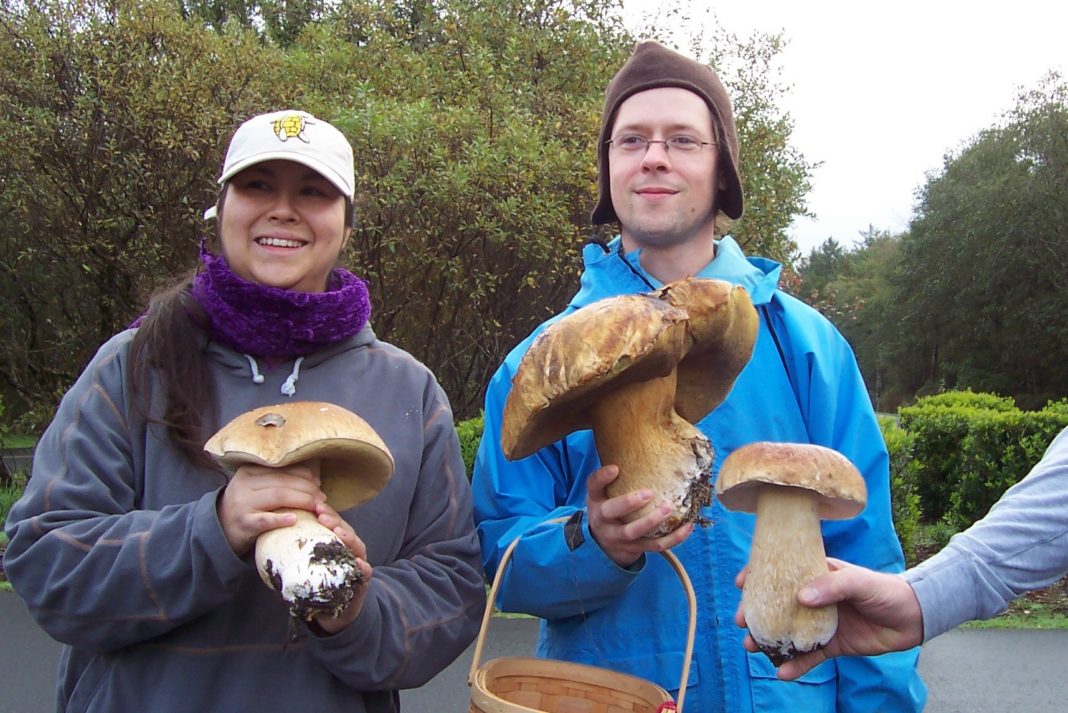Fall rain in the Northwest brings more than snow to our mountains. That rain is germinating mushroom spores scattered on the forest floor. But like many of nature’s offerings, there is an art to reaping the rewards.
 Thurston County is prime mushroom hunting territory, but only for those who know where to look and what to look for. Thrifty Thurston provides this insider glimpse into the secretive world of the mushroom hunter.
Thurston County is prime mushroom hunting territory, but only for those who know where to look and what to look for. Thrifty Thurston provides this insider glimpse into the secretive world of the mushroom hunter.
The First Rule of Mushroom Club: You Do Not Talk about Mushroom Club
Okay, mushroom hunting isn’t exactly a secret society, but be forewarned that each mushroom gatherer is very protective of their “patch.” Local mushroom experts Richard Gaines and Tom Keller have both led numerous classes, talks, and tours for novice and experienced mushroom hunters. While incredibly knowledgeable, and very generous in sharing that knowledge, there is a point where that generosity ends. Asking Richard, for example, where he and fellow mushroom experts Dusty Yao and Paul Stamets located the famous Candy Cap mushroom, elicits a full belly laugh. Here is a video of that discovery and Dusty’s joyful claim to the patch.
So, when asked where Richard plans to take photographer Claudia Hellwig and me to hunt, Richard pauses, narrows his eyes and says, “Let’s just call it Capitol Forest.” Recalling the first rule of mushroom club, we set off with that very general description.
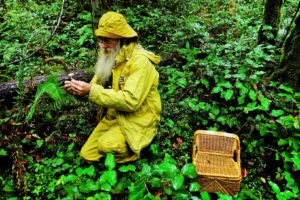
But before you jump in the car, there are a few other rules to keep in mind.
No Gobbling Unknown Fungi
Richard advises novice foragers to make sure they have a good mushroom book on hand. “And read about the poisonous mushrooms first,” Richard warns, “because it’s knowing that you don’t know the dangers that’s important. You always learn a lot faster if you go out with someone who already knows about mushrooms. I self-learned it and it was a long hard slog to be learning from books.” Barring an agreeable friend willing to share the location of their patch, you may need to rely on pictures and descriptions.
Tom agrees, “Make sure you are 100% sure of what you are eating and never eat a mushroom unless they have been 100% identified. There are some that will kill you, so you have to be careful.”
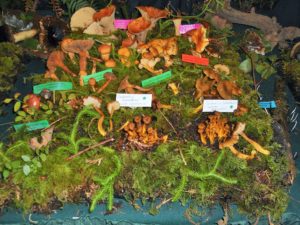
A few books that are generally regarded as the best beginner guides include The New Savory Wild Mushroom by Margaret McKinney and Daniel Stunts, All that the Rain Promises and More by Dave Arora, and Mushrooms of the Pacific Northwest by Trudell and Ammarati. These can be tough to find this time of year, but can be ordered locally online here.
You Reap What You Sow
Watch your step. Young mushrooms are often found under leaves on the forest floor, so take care. If you pick mushrooms when too young, they have not had a chance to mature and drop spores to replenish the patch. Larger cap sizes indicate that the mushroom is mature. Another factor is the use of loose weave bags or baskets for gathering your harvest. This helps continue the process of spreading the spores even after the mushroom has been picked. You want that patch and the surrounding area to still be mushroom-rich the next time you visit.
Many advise that if you find two chanterelles, pick one and leave one. Same with any group of mushrooms, try to resist the urge to take everything there to allow the patch to propagate.

This also supports Richard’s advice to not overindulge in eating mushrooms if your body is not accustomed to them. Like any new food, it can cause intestinal distress if you eat too many at first.
Excluding the standard cap or button mushrooms like those in grocery stores, mushrooms do require cooking.
Watch Where You Go
So if you are doing a good job and treading lightly, chances are you may not be paying attention to your surroundings. “Don’t go mushroom hunting by yourself,” Tom advises, “because if you injure yourself, you may need help getting back. In my classes, we teach how to use a compass and GPS to get back to your car. Mushroom hunters are always looking at the ground and they are not paying attention to their surroundings. The main thing is making sure you always know where you are.”
Let the Hunt Begin
Where to go? Luckily, we live in the Evergreen State. “The evergreen forest, a douglas fir forest,” Richard clarifies, “is a great place to look. Anyplace that is easy enough to walk around. But mushrooms are everywhere – they are in people’s yards and around their house, in pastures. But if you are wanting to collect a lot of mushrooms, or find the chanterelle, go into the evergreen forest.”
Chanterelle are the most sought-after of our local mushrooms. They appear both in spring and fall, unlike morels which usually come up only in the spring. Mushrooms are tricky to identify. If you try to use limited pictures, they can be easily misidentified. Even a Chanterelle can be mixed-up, there are two types – the true and false Chanterelle. “The true Chanterelles are firm,” explains Richard, “and the false are very soft. They won’t hurt you, but they just aren’t good to eat.”
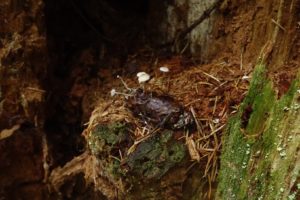
Look, Feel and Smell
On our walk, Richard identified mushrooms using multiple techniques. He used the information of the area around the mushroom as well as the mushroom itself. Though it isn’t necessary to cut a mushroom for gathering (there are two distinct schools of thought on that) Richard used his pocket knife several times to slice the cap and check the color of the lacteous or milky liquid within. He also manipulated the gills under the cap and felt the surface of the cap. Then, bringing the mushroom close to his nose, determined the smell it emanates. Turns out there are an amazing number of odors associated with mushrooms, everything from apricot to cucumber.
Sharing the Knowledge
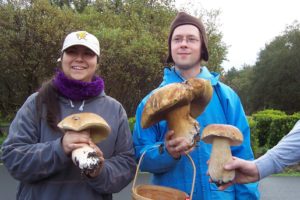
Photo credit: Tom Keller
Tom is a past president and an active member of the South Sound Mushroom Club. He recommends that you join a club to learn the ropes – you can visit South Sound Mushroom Club online here. The club offers mushroom hunting forays, a lending library, cookbooks, and monthly meetings where you can bring specimens for identification. “People bring in their mushrooms,” says Tom, “and we have display tables where they can lay them out and then we I.D. them. It is a good way to see mushrooms up close, to touch them and smell them.”
For those who appreciate mushrooms but not the work to find them, the nationally recognized Olympia company, Fungi Perfecti, offers start-up kits to grow your own crops at home. While mushroom gardening definitely requires less cloak and dagger tactics to protect your patch, you may find that you miss out on the camaraderie, secrecy, and exercise of mushroom hunting.
Gallery Boom is hosting a Mushroom Party November 6 – 11 with exhibits from local artists featuring mycological art. The South Sound Mushroom Club will also be there with a table of mushroom samples you can practice your identification skills on. To learn more about the party, visit the Gallery Boom event page here.









































